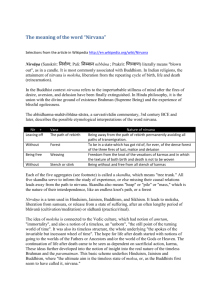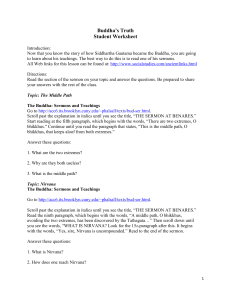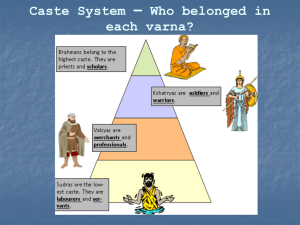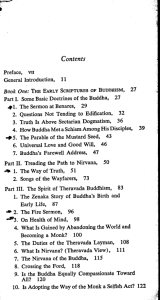(II) ion by Pyridine 2, 3 dicarboxyl
advertisement
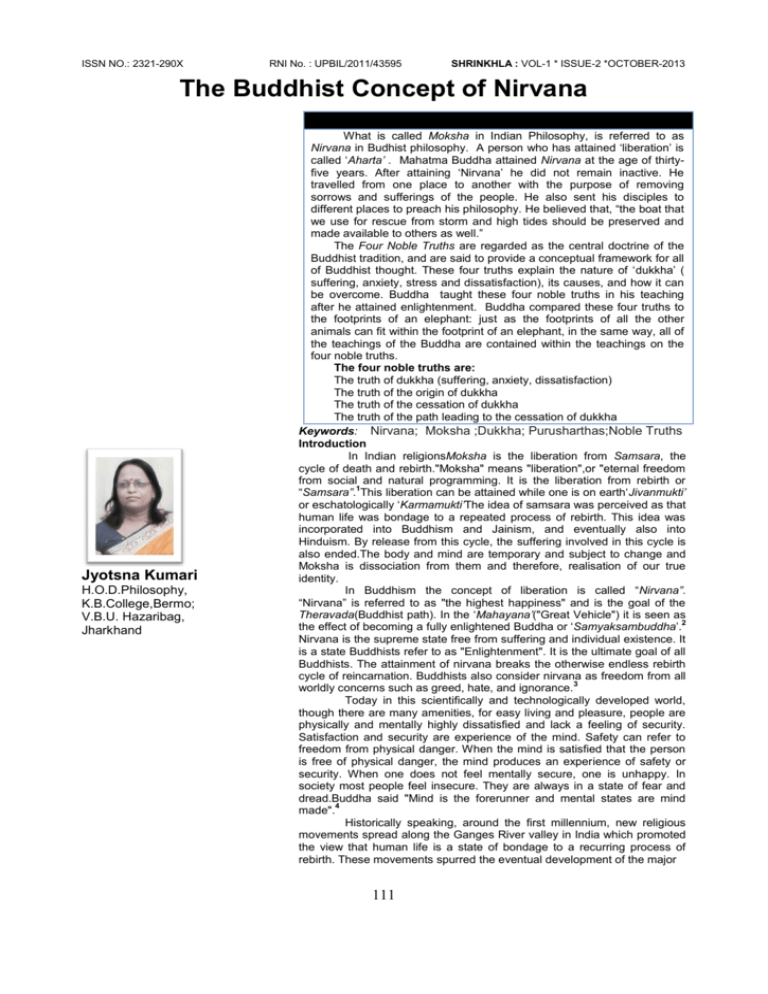
ISSN NO.: 2321-290X RNI No. : UPBIL/2011/43595 SHRINKHLA : VOL-1 * ISSUE-2 *OCTOBER-2013 The Buddhist Concept of Nirvana Abstract Jyotsna Kumari H.O.D.Philosophy, K.B.College,Bermo; V.B.U. Hazaribag, Jharkhand What is called Moksha in Indian Philosophy, is referred to as Nirvana in Budhist philosophy. A person who has attained „liberation‟ is called „Aharta’ . Mahatma Buddha attained Nirvana at the age of thirtyfive years. After attaining „Nirvana‟ he did not remain inactive. He travelled from one place to another with the purpose of removing sorrows and sufferings of the people. He also sent his disciples to different places to preach his philosophy. He believed that, “the boat that we use for rescue from storm and high tides should be preserved and made available to others as well.” The Four Noble Truths are regarded as the central doctrine of the Buddhist tradition, and are said to provide a conceptual framework for all of Buddhist thought. These four truths explain the nature of „dukkha‟ ( suffering, anxiety, stress and dissatisfaction), its causes, and how it can be overcome. Buddha taught these four noble truths in his teaching after he attained enlightenment. Buddha compared these four truths to the footprints of an elephant: just as the footprints of all the other animals can fit within the footprint of an elephant, in the same way, all of the teachings of the Buddha are contained within the teachings on the four noble truths. The four noble truths are: The truth of dukkha (suffering, anxiety, dissatisfaction) The truth of the origin of dukkha The truth of the cessation of dukkha The truth of the path leading to the cessation of dukkha Keywords: Nirvana; Moksha ;Dukkha; Purusharthas;Noble Truths Introduction In Indian religionsMoksha is the liberation from Samsara, the cycle of death and rebirth."Moksha" means "liberation",or "eternal freedom from social and natural programming. It is the liberation from rebirth or 1 “Samsara”. This liberation can be attained while one is on earth„Jivanmukti’ or eschatologically „Karmamukti’The idea of samsara was perceived as that human life was bondage to a repeated process of rebirth. This idea was incorporated into Buddhism and Jainism, and eventually also into Hinduism. By release from this cycle, the suffering involved in this cycle is also ended.The body and mind are temporary and subject to change and Moksha is dissociation from them and therefore, realisation of our true identity. In Buddhism the concept of liberation is called “Nirvana”. “Nirvana” is referred to as "the highest happiness" and is the goal of the Theravada(Buddhist path). In the „Mahayana’("Great Vehicle") it is seen as 2 the effect of becoming a fully enlightened Buddha or „Samyaksambuddha‟. Nirvana is the supreme state free from suffering and individual existence. It is a state Buddhists refer to as "Enlightenment". It is the ultimate goal of all Buddhists. The attainment of nirvana breaks the otherwise endless rebirth cycle of reincarnation. Buddhists also consider nirvana as freedom from all 3 worldly concerns such as greed, hate, and ignorance. Today in this scientifically and technologically developed world, though there are many amenities, for easy living and pleasure, people are physically and mentally highly dissatisfied and lack a feeling of security. Satisfaction and security are experience of the mind. Safety can refer to freedom from physical danger. When the mind is satisfied that the person is free of physical danger, the mind produces an experience of safety or security. When one does not feel mentally secure, one is unhappy. In society most people feel insecure. They are always in a state of fear and dread.Buddha said "Mind is the forerunner and mental states are mind 4 made". Historically speaking, around the first millennium, new religious movements spread along the Ganges River valley in India which promoted the view that human life is a state of bondage to a recurring process of rebirth. These movements spurred the eventual development of the major 111 ISSN NO.: 2321-290X RNI No. : UPBIL/2011/43595 SHRINKHLA : VOL-1 * ISSUE-2 *OCTOBER-2013 The Four Noble Truths are regarded as the central doctrine of the Buddhist tradition, and are said to provide a conceptual framework for all of Buddhist thought. These four truths explain the nature of „dukkha‟(suffering, anxiety, stress and dissatisfaction), its causes, and how it can be overcome.Buddha taught these four noble truths in his teaching after he attained enlightenment.Buddha compared these four truths to the footprints of an elephant: just as the footprints of all the other animals can fit within the footprint of an elephant, in the same way, all of the teachings of the Buddha are contained within the teachings on the four noble truths. The four noble truths are: 1. The truth of dukkha (suffering, anxiety, dissatisfaction) 2. The truth of the origin of dukkha 3. The truth of the cessation of dukkha 4. The truth of the path leading to the cessation of dukkha. Buddha taught on the four noble truths repeatedly throughout his lifetime, continually expanding and clarifying his meaning. 1. The truth of dukkha(Suffering) Suffering comes in many forms. Three obvious kinds of suffering correspond to the first three sights the Buddha saw on his first journey outside his palace: old age, sickness and death. The problem of suffering goes much deeper. Life is not ideal and it frequently fails to live up to our expectations.Human beings are subject to desires and cravings, but even when we are able to satisfy these desires, the satisfaction is only temporary. Pleasure does not last; or if it does, it becomes monotonous.Even when we are not suffering from outward causes like illness or bereavement, we are unfulfilled, unsatisfied. This is the truth of suffering. 2.The truth of the origin of dukkha Buddha preached that the root of all suffering is desire „Tanha’(a term in Pali which means craving or misplaced desire).This comes in three forms, which he described as the „Three Roots of Evil‟, or the „Three Fires‟, or the „Three Poisons‟. These three ultimate causes of suffering are „greed and desire‟;„ignorance or delusion‟; and „hatred and destructive urges‟. 3. The truth of the cessation of dukkha Buddha explained that the way to extinguish desire, which causes suffering, is to liberate oneself from attachment.If the cause of life‟s suffering is those inclinations which tend to continue or increase separativeness, then its cure lies in the overcoming of such cravings. If we can be released from the narrow limits of self-interest into the vast expanse of universal life, we will be free of our torment.The overcoming of desire is through substitution of the personal wants with divine inclinations. 4.The truth of the path leading to the cessation of dukkha. The final Noble Truth is the Buddha's prescription for the end of suffering. This is a set of principles called the Eightfold Path. The Eightfold Path is also called the Middle Wayas it avoids both indulgence and severe asceticism, neither of which religions of Buddhism, Jainism, and subsequently Hinduism. These and many other religious traditions offered differing conceptions of bondage and diverging paths to Moksha. Some forms of Buddhism and the monistic theologies of Hinduism like AdvaitaVedanta, consider both the mundane world and human entrapment within it to be a web of illusion. Its penetration requires both mental training through meditative techniques and the attainment of liberating insight. In this case, the passage from bondage to liberation is not a real transition but an epistemological transformation that permits one to see the truly real behind the fog of 5 ignorance. Indian religions consider thePurusharthasas the mainstay of their philosophy.The concept of Purushartha basically indicates different valuesto be realized in human life through human efforts. There are four Purusharthas or aims of life as Propounded by Manu. They areDharma (virtue), Artha (wealth), Kama (pleasure), and Moksha (liberation).One can find the reference of these Purusharthas in various texts of Indian Philosophy.Moksha means to get „rid off‟ or„release‟. It is commonly understood asliberation. In BhagavadGita, Moksha is mentioned as“the supreme tranquility 6 and the highest bliss” . It isdelight in the self, contentment with the self, self-satisfactionand selffulfillment. It is the highest endof life, attainable only by the individual himself, withthe help and guidance of dharma. Moksha as the lastend signifies that its attainment is possible after fulfilling the obligations of the other three. It is astate of non-action. It is not that on death Moksha isattained. Being the ultimate value of man‟s social existence, the purusharthaof Moksha is an end in itself.Beyond that, man has nothing to attain. It is the stagewhere man‟s cravings cease and along with thatceases the need for attainment and fulfillment. It isrealization and living of the truth namely AhamBrahma,Asmi and Tat TvamAsi. In other words it iswaking up of human consciousness at the 7 highestlevel of reality i.e., Paramarthik Satta. The liberatedperson neither acts nor causes others to act. He maywork for the good of humanity without moralobligation. But he has no duties to perform. It istotal destruction of egoism. We can call Moksha as asublime goal. It can be known through mysticalexperience. Many saints like Tukaram andKabir havetalked about it and ultimately we all have to aim at itand only then we will be able to come out of thecycle of birth and death. ‘Moksha’ and‘Nirvana’are one and the same. What is called Moksha in Indian Philosophy, is referred to as Nirvana in Budhist philosophy. A person who has attained „liberation‟ is called „Aharta’ . Mahatma Buddha attained Nirvana at the age of thirty-five years. After attaining „Nirvana‟ he did not remain inactive. He travelled from one place to another with the purpose of removing sorrows and sufferings of the people. He also sent his disciples to different places to preach his philosophy. He believed that, “the boat that we use for rescue from storm and high tides should be preserved and made available to 8 others as well.” 112 ISSN NO.: 2321-290X RNI No. : UPBIL/2011/43595 SHRINKHLA : VOL-1 * ISSUE-2 *OCTOBER-2013 Parinirvana(final nirvana) in the afterlife. Souls that have achieved „parinirvana‟ are free of the cycle of reincarnation. However, Buddha never specified what parinirvana was like. In Buddhist thought, it is beyond normal human comprehension. The implication of Nirvana is that it is freedom from whatever binds you, from the burning passion of desire, jealousy, and ignorance. Once these are totally overcome, a state of bliss is achieved, and the cycle of birth and death along with all karmic debts are settled. References : 1. Sharma, Arvind (2000), Classical Hindu Thought: An Introduction, Oxford University Press. Steven 2. Collins. Nirvana: Concept, Imagery, Narrative (Cambridge University Press; 2010) Kawamura, 3. Bodhisattva Doctrine in Buddhism, Wilfrid Laurier University Press, 1981. 4. AcharyaBuddharakkhita, The Buddha's Path of Wisdom- The Dhammapada (translated from the Pali), Bhikkhu Bodhi, 1996 5. Patrick OlivellePresuppositions of India’s Philosophies (1963). "moksha". Encyclopædia Britannica. . 6. Chatterjee, Satischandra; Datta, Dhirendramohan (1984). An Introduction to Indian Philosophy (Eighth Reprint Edition ed.). Calcutta: University of Calcutta. 7. Sharma, Arvind (2000), Classical Hindu Thought: An Introduction, Oxford University Press 8. KashiNathUpadhyaya, Early Buddhism and the Bhagavadgita.MotilalBanarsidass Publ., 1998 9. Snelling, John. The Buddhist Handbook: A Complete Guide to Buddhist Schools, Teaching, Practice, and History. Rochester: Inner Traditions, 1991. the Buddha had found helpful in his search for enlightenment. 1. Right Understanding - Sammaditthi- Complete or Perfect Vision, also translated as right view or understanding. It implies visualising of the nature of reality and the path of transformation. 2. Right Intention - Sammasan kappa-Perfected Emotion or Aspiration, also translated as right thought or attitude. It means liberating emotional intelligence in one‟s life and acting from love and compassion 3. Right Speech - Sammavaca-Perfected or whole Speech. Clear, truthful, uplifting and non-harmful communication is its essence. 4. Right Action - Sammakammanta-Integral Action. An ethical foundation for life based on the principle of non-exploitation of oneself and others 5. Right Livelihood Sammaajiva-Proper Livelihood.This is a livelihood based on correct action the ethical principal of non-exploitation. This is the basis of an ideal society. 6. Right Effort - Sammavayama-Complete or Full Effort, Energy or Vitality. It means consciously directing our life energy to the transformative path of creative and healing action that fosters wholeness and therefore there is conscious evolution. 7. Right Mindfulness - Samma sati Complete or Thorough Awareness..Right mindfulness is the controlled and perfected faculty of cognition. It is the mental ability to see things as they are, with clear consciousness. 8. Right Concentration - SammaSamadhi-Full, Integral or Holistic Samadhi. Samadhi literally means to be fixed, absorbed in or established at one point, thus the first level of meaning is concentration when the mind is fixed on a single object. The second level of meaning goes further and represents the establishment, not just of the mind, but also of the whole being in various levels or modes of consciousness and awareness. This is Samadhi in the sense of enlightenment . The Buddha described the Eightfold Path as a means to enlightenment, like a raft for crossing a river. Once one has reached the opposite shore, one 9 no longer needs the raft and can leave it behind. In Buddhism, attaining this state of enlightenment is called „Nirvana’. The word is Sanskrit for "to extinguish." In this case, it means to extinguish ignorance, hatred and earthly suffering. The term is most closely associated with Buddhism, though it's applied to a same concept in Hinduism.A primary aim of Buddhism is to break free of the wheel of samsara, and to reach a new level called Nirvana.By achieving nirvana,one can escape samsara, the cycle of reincarnation that characterizes both Hinduism and Buddhism. In each life, a soul is punished or rewarded based on its past actions, or karma, from the current life as well as earlier lives (which also include lives as animals.When one achieves nirvana, he stops accumulating bad karma because one has transcended it. One then spends the rest of his life and sometimes future lives "working off" the bad karma that had already accumulated. Once you have fully escaped the karmic cycle, you achieve 113



